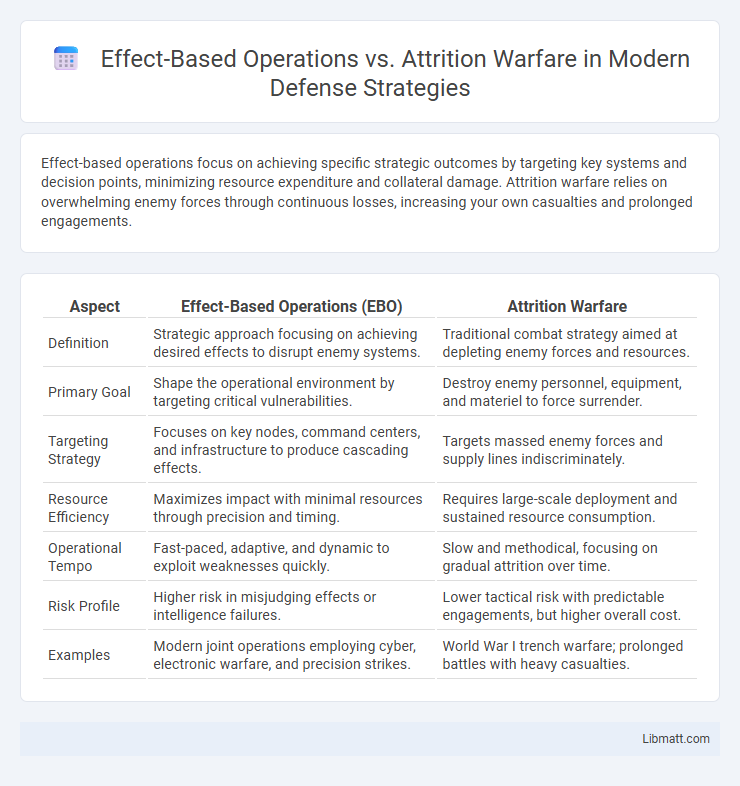Effect-based operations focus on achieving specific strategic outcomes by targeting key systems and decision points, minimizing resource expenditure and collateral damage. Attrition warfare relies on overwhelming enemy forces through continuous losses, increasing your own casualties and prolonged engagements.
Table of Comparison
| Aspect | Effect-Based Operations (EBO) | Attrition Warfare |
|---|---|---|
| Definition | Strategic approach focusing on achieving desired effects to disrupt enemy systems. | Traditional combat strategy aimed at depleting enemy forces and resources. |
| Primary Goal | Shape the operational environment by targeting critical vulnerabilities. | Destroy enemy personnel, equipment, and materiel to force surrender. |
| Targeting Strategy | Focuses on key nodes, command centers, and infrastructure to produce cascading effects. | Targets massed enemy forces and supply lines indiscriminately. |
| Resource Efficiency | Maximizes impact with minimal resources through precision and timing. | Requires large-scale deployment and sustained resource consumption. |
| Operational Tempo | Fast-paced, adaptive, and dynamic to exploit weaknesses quickly. | Slow and methodical, focusing on gradual attrition over time. |
| Risk Profile | Higher risk in misjudging effects or intelligence failures. | Lower tactical risk with predictable engagements, but higher overall cost. |
| Examples | Modern joint operations employing cyber, electronic warfare, and precision strikes. | World War I trench warfare; prolonged battles with heavy casualties. |
Understanding Effect-Based Operations
Effect-Based Operations (EBO) prioritize achieving strategic outcomes by targeting the enemy's critical vulnerabilities and system functions, rather than solely focusing on the destruction of enemy forces as in attrition warfare. This approach leverages intelligence, precision strikes, and information operations to disrupt or influence adversary decision-making processes, thereby reducing the need for prolonged combat. Understanding EBO enhances operational efficiency by aligning military actions with desired psychological, economic, and political effects, minimizing collateral damage and resource expenditure.
Defining Attrition Warfare
Attrition warfare is a military strategy focused on inflicting continuous losses on the enemy's personnel, equipment, and resources to gradually reduce their combat effectiveness. This approach emphasizes sustained engagements, aiming to wear down the opposition through superior force and endurance rather than precision or targeted outcomes. Effect-based operations contrast by prioritizing specific, strategic effects on enemy capabilities to achieve mission objectives efficiently, minimizing unnecessary losses.
Core Principles: EBO vs. Attrition Approaches
Effect-Based Operations (EBO) center on achieving strategic objectives by targeting enemy systems and critical nodes to disrupt their overall capabilities, emphasizing precision and efficiency. Attrition warfare focuses on gradually degrading enemy forces through sustained direct combat and resource depletion, prioritizing quantity and persistence over precision. Your understanding of these core principles highlights how EBO seeks to minimize collateral damage by focusing on cause-and-effect relationships, while attrition relies on overwhelming force and attritional damage.
Historical Evolution of Military Doctrines
Effect-based operations emphasize achieving strategic outcomes by targeting critical systems and decision-making processes, contrasting with attrition warfare's focus on wearing down enemy forces through sustained combat. Historically, military doctrines evolved from large-scale, attrition-centered conflicts like World War I to more precise, technology-driven strategies seen in modern conflicts such as the Gulf War. Understanding this shift helps you appreciate how contemporary military approaches prioritize efficiency and disruption over sheer numerical advantage.
Strategic Objectives: Outcomes vs. Exhaustion
Effect-based operations prioritize achieving specific strategic objectives by targeting critical systems and influencing enemy decision-making, resulting in desired outcomes with minimal force expenditure. Attrition warfare focuses on wearing down enemy forces through sustained combat and resource depletion, aiming to exhaust your opponent's capacity to fight. Choosing effect-based ops allows for more precise and efficient realization of long-term goals compared to the often prolonged and costly nature of attrition warfare.
Decision-Making in EBO and Attrition Warfare
Decision-making in Effect-Based Operations (EBO) centers on targeting specific enemy systems and behaviors to achieve strategic outcomes with minimal force, relying heavily on intelligence, precision, and real-time information. In contrast, attrition warfare decision-making emphasizes sustaining continuous pressure through overwhelming force and resource depletion, prioritizing measurable enemy losses over nuanced effects. EBO decision-makers integrate multidimensional data to adapt quickly, while attrition warfare commanders focus on metrics like enemy combatants killed or material destroyed to guide operational progress.
Operational Flexibility and Adaptation
Effect-based operations enhance operational flexibility by targeting specific systems and behaviors, enabling rapid adaptation to changing battlefield conditions without relying solely on force accumulation. Attrition warfare depends on sustained resource expenditure and linear force application, limiting adaptability to dynamic threats. Emphasizing precise, system-level effects allows commanders to adjust strategies in real-time, optimizing mission outcomes with reduced collateral damage.
Resource Utilization and Efficiency
Effect-based operations prioritize precise, targeted actions that maximize resource efficiency by achieving strategic outcomes without engaging in prolonged conflict. Attrition warfare relies heavily on sustained resource consumption and manpower, often resulting in significant logistical strain and diminished operational efficiency. Your military strategy benefits from effect-based ops through optimized asset utilization, reducing wastage and enhancing mission success rates.
Impact on Morale and Civilian Populations
Effect-based operations prioritize precise, strategic targeting that minimizes collateral damage, thereby preserving civilian morale and support while degrading enemy capabilities. Attrition warfare often results in prolonged conflict and extensive casualties, severely damaging civilian infrastructure and lowering morale among both combatants and non-combatants. The psychological impact of effect-based operations tends to be more focused and sustainable, whereas attrition warfare commonly fosters resentment and resistance within civilian populations.
Modern Conflicts: Lessons and Future Trends
Effect-based operations prioritize precision targeting to disrupt enemy capabilities and decision-making processes, contrasting with attrition warfare's focus on wearing down forces through sustained losses. Modern conflicts demonstrate the effectiveness of effect-based strategies in minimizing collateral damage while achieving strategic objectives quickly. Future trends suggest increased reliance on advanced technologies like AI and cyber warfare to enhance effect-based approaches, reducing the need for traditional attrition methods.
effect-based ops vs attrition warfare Infographic

 libmatt.com
libmatt.com